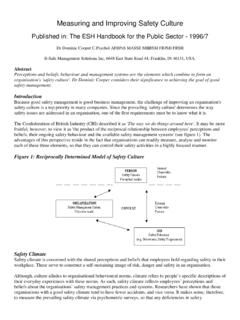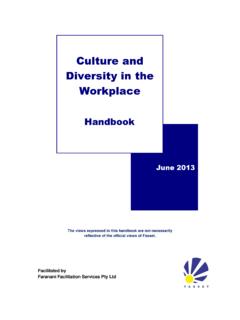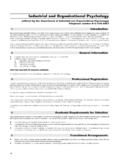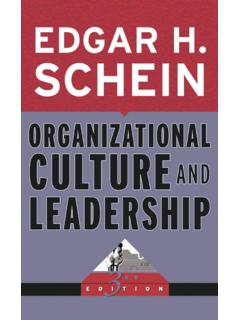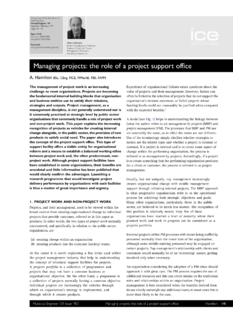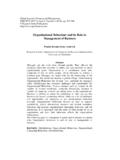Transcription of Organisational Culture CPMR40a - CPMR Home
1 Understanding and ManagingOrganisational CultureOrla O DonnellRichard BoyleCPMR Discussion Paper40 Understanding and ManagingOrganisational CultureFirst published in 2008by the Institute of Public Administration57-61 Lansdowne RoadDublin 4 Irelandin association withThe Committee for Public Management 2008 with the Institute of Public AdministrationAll rights reserved. No part of this publication may bereproduced or transmitted in any form or by any means,electronic or mechanical, including photocopying, recordingor any information storage and retrieval system, withoutpermission in writing from the Library Cataloguing in Publication DataA catalogue record for this book is available from the : 978-1-904541-75-2 ISSN: 1393-6190 Cover design by Creative Inputs, DublinTypeset by the Institute of Public AdministrationPrinted by ColourBooks Ltd, DublinCONTENTSA cknowledgmentsviiExecutive SummaryviiiChapter 1: Policy context Terms of reference and study Report structure3 Chapter 2: Organisational Culture : lessons from is Organisational Culture ?
2 Of Organisational is Culture important? in managing Conclusion14 Chapter 3: International public and private sector examples of Culture management : Culture change in the Queensland public Kong and Shanghai Banking 4: Irish public service experience with central government public sector local chapter findings59 Chapter 5: Conclusions and is Culture ? The concept of Culture is Culture an important issue for public service managers? can managers do to influence/shape Culture ? 174 Appendix 282 References88viThis study on Understanding and Managing OrganisationalCulturecould not have been completed successfully withoutthe active support and co-operation of officials in a numberof public service organisations. Special thanks are due toBrigid McManus, (Secretary General, Department ofEducation and Science); Catherine Treacy (Chief Executive,Property Registration Authority); Dr.
3 Ciaran Kissane,(Director of Corporate Services, Broadcasting Commissionof Ireland); Joe Crockett, (formerly County Manager, CarlowCounty Council and at present County Manager of KilkennyCounty Council); Phil Furlong, (former Secretary General,Department of Arts, Sport and Tourism); Michael McLoone(County Manager, Donegal County Council) and SeanSheridan (Director of Corporate Services, Donegal CountyCouncil); Frank Daly (formerly Chairman, The Office of theRevenue Commissioners and at present Chairperson of theCommission on Taxation) and Joe Horan (County Manager,South Dublin County Council) who provided wholeheartedsupport to the in-depth case-study analysis of theirrespective organisations. In addition, the informationprovided by members of the Committee for PublicManagement Research and Dr.
4 Paul Mc Grath and Geaney, UCD Michael Smurfit School of Business,proved very for the content of the paper, however, restswith the O DonnellRichard BoyleJune 2008viiACKNOWLEDGMENTSI ntroductionOrganisational Culture is a widely used term but one thatseems to give rise to a degree of ambiguity in terms ofassessing its effectiveness on change variables in anorganisation. For the past number of decades, mostacademics and practitioners studying organisations suggestthe concept of Culture is the climate and practices thatorganisations develop around their handling of people(Schein, 2004). Watson (2006) emphasises that an importanttrend in managerial thinking in recent decades has been oneof encouraging managers to try to create strongorganisational cultures.
5 Schein (2004) suggests that cultureand leadership are conceptually intertwined. This issupported by O Farrell (2006) in his analysis of theAustralian public service, where he concludes that statements of values, codes of conduct, principles of publicservice management and so on set out in rules andregulation are simply rhetoric or what we now callaspirational statements. Without leadership that is what theywill ever be rhetoric. It is our job as administrators, managersand leaders to turn them into reality (O Farrell, 2006. ).This study reviews evidence that shows why managingculture is important to effectively enhancing bothorganisation performance and, in macro terms, the publicservice modernisation programme.
6 Based on the nationaland international literature reviewed and interviewsconducted, guidance is provided in relation to moreeffectively managing Culture , and issues to be addressed interms of its effective engagement and use in the publicservice are is Culture an important issue for public servicemanagers?Why should public service managers concern themselveswith Culture ? Will it make any difference at the end of theday to know what type of Culture or subcultures exist in anorganisation, what cultural traits may be desired, and soon? For managers with busy schedules, is culturesomething they should be concerned with?viiiEXECUTIVESUMMARYThe evidence presented here, from the literature,international studies and the Irish experience, suggeststhat Culture is indeed something that public servicemanagers should pay attention to.
7 First and foremost, thisis because Culture affects the performance of the private sector organisations studied The Hong Kongand Shanghai Banking Corporation and 3M there is aclear and explicit link between Culture change andperformance. But this can also be the case in the publicsector, despite the absence of a bottom line . Ban s (1995)study of the good performance of the US EnvironmentalProtection Agency compared to other federal agencies, citedin Chapter 2, shows how Culture can affect Irish cases studied, such as the BroadcastingCommission of Ireland (BCI) and the Property RegistrationAuthority (PRA) would also suggest that attention paid toculture influences performance in a positive evidence from this study would also suggest that itis particularly important for managers to pay attention toculture when reacting to or planning major organisationalchange.
8 Culture is particularly important when anorganisation is undergoing significant transformation orwhen introducing major reforms which require different ornew cultural or value traits from those exhibited in the can managers do to influence/shape Culture ?Knowing that Culture is important in shapingorganisational practice and performance in public sectororganisations is one thing. But a subsequent issue is theextent to which managers can actually shape or influenceculture. The literature on Culture change explored inChapter 2 is somewhat ambivalent on this point. On theone hand, examples can be identified where interventionscan influence Culture . But on the other hand, someacademics warn of the danger of attempting to influence themore superficial aspects of Culture such as symbols andceremonies, while ignoring the more pervasive and deepseated aspects of Culture such as values and beliefs.
9 Thesemore deep seated aspects of Culture are much more difficultto key issuesBased on the academic literature in this study and thefindings from the interviews, Chapter 5 sets out aframework that identifies six key issues that managers needto address in order to contribute to creating a moredevelopmental and performance oriented Culture in theirorganisation. These issues are as follows:1. Creating a climate for changeIn terms of creating a climate for change, Culture is onlyeffective if it is applied to the relevant area needing changeor is tied to some Organisational issue. Several of theorganisations studied here used internal or external driversin order to facilitate the Culture shift they wanted to seeachieved. For example, the UK civil service at the unfreezing stage of their change programme created aclimate where civil service change to a more managerialculture was seen as required in order to address longstanding problems.
10 The Department of Education andScience uses the social partnership agreements as aframework within which to promote change. BCI has usedits Organisational development policy as the driver fordeveloping the organisation s Culture in the Leaders as championsLeadership is clearly important in determining theeffectiveness of Culture change. The leaders of organisationsare champions of understanding and managing Culture inthe organisation and of rewarding or punishing subculturesdepending on whether they align or not with the corporateculture espoused by the leaders. The influence of leaders interms of rewarding the sub- Culture groups that espouse thedominant beliefs, values and underlying assumptions of theorganisation cannot be underestimated.




